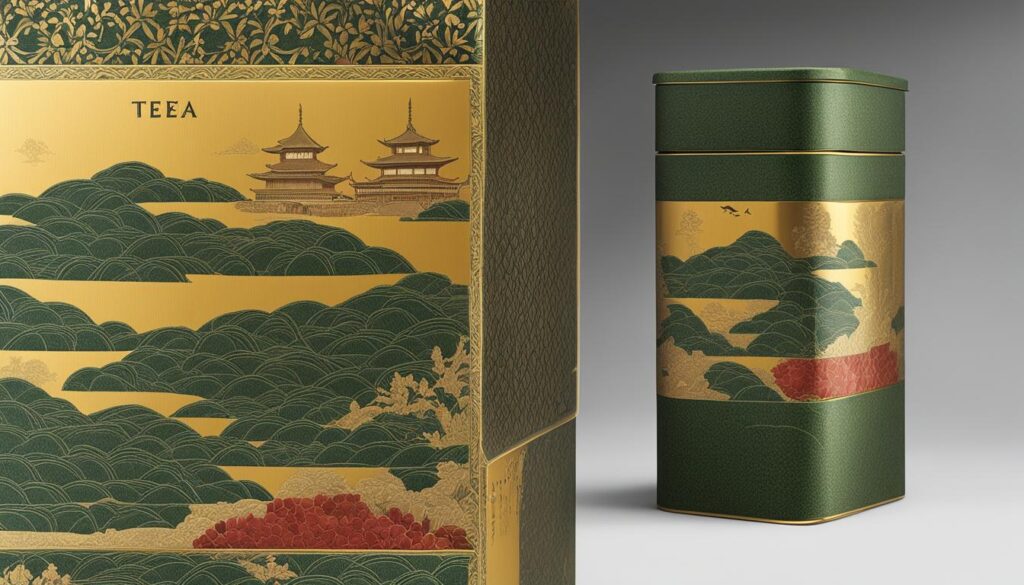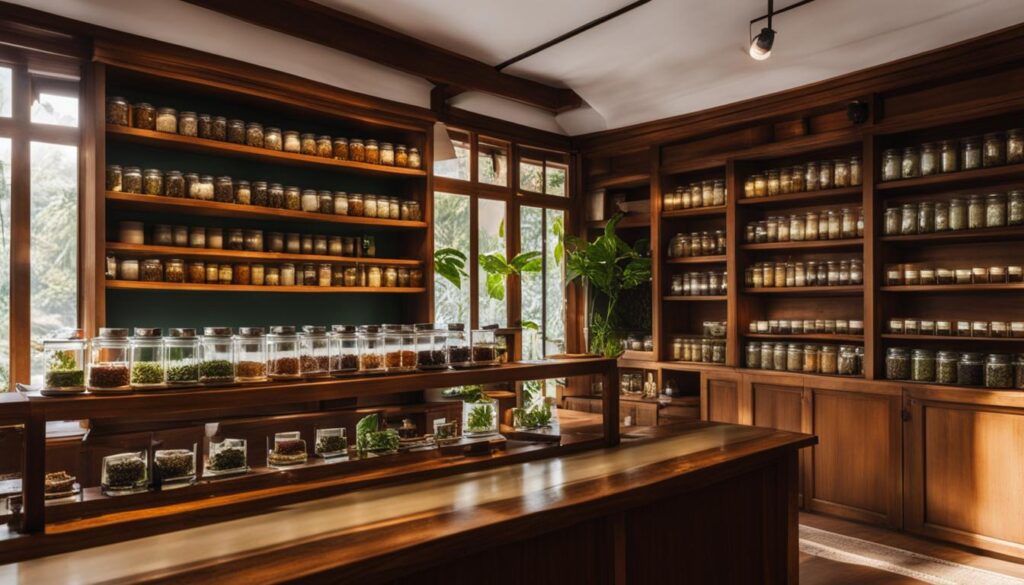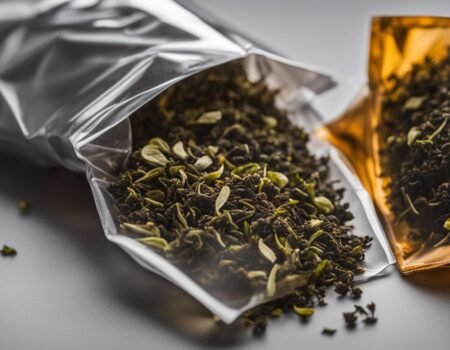
Optimizing Freshness: Advanced Tea Storage Methods
Tea storage has always been a crucial aspect of preserving the quality and flavor of tea. Over the years, various methods have been employed, from lead pots and bamboo baskets to tin cans and caves. These methods offered unique benefits for tea preservation, but with the increasing global consumption of tea, the need for advanced storage techniques has become more important than ever.
At [Website Name], we are committed to exploring and sharing the best methods for tea freshness. In this article, we will delve into the techniques for preserving tea freshness in tea tins, tea bags, tea containers, and more. Whether you’re an avid tea lover or a tea connoisseur, these methods will help you optimize the freshness of your favorite brew.
Before we dive into the specifics, let’s highlight some key takeaways:
Key Takeaways:
- Tea freshness can be maximized through advanced storage methods
- Proper storage techniques are essential for preserving tea flavor and aroma
- Tea tins, tea bags, and tea containers play a significant role in maintaining freshness
- Choosing the right packaging material is crucial for protecting tea from external factors
- Storage temperature plays a vital role in maintaining tea quality
Now, let’s explore the best methods for preserving tea freshness in different storage contexts.
The Significance of Tea Packaging in Preserving Freshness
The preservation of tea freshness is closely linked to the choice of packaging. Proper tea packaging is crucial in protecting tea from light, moisture, air, and oxidation, all of which can degrade the quality and flavor of tea. Traditional packaging materials such as paper-based packaging and tin containers have been widely used, offering varying degrees of protection against these factors. However, newer packaging options such as foil packaging, vacuum-sealed packaging, and biodegradable packaging are gaining popularity for their ability to provide enhanced protection and preservation of tea freshness. Each type of packaging has its advantages and suitability for different tea varieties. Understanding the significance of tea packaging and selecting the appropriate packaging material is essential for maximizing tea freshness.

When it comes to tea packaging, various factors should be considered to ensure optimal freshness. One of the key considerations is the level of protection offered against light exposure. Light can cause tea leaves to deteriorate and lose their flavor. Foil packaging, for example, provides excellent light-blocking properties, preventing harmful UV rays from reaching the tea leaves. Vacuum-sealed packaging also offers enhanced protection against light, as well as air and moisture, by creating an airtight seal that preserves the freshness of the tea.
The choice of packaging also depends on the specific type of tea being stored. For example, delicate tea leaves, such as green tea, require extra care to preserve their freshness. Packaging options such as tea pouches or biodegradable packaging can help maintain the delicate flavors and aromas of green tea. These packaging materials are designed to minimize air and moisture exposure, ensuring that the tea retains its freshness for longer periods.
| Packaging Material | Advantages | Suitability |
|---|---|---|
| Paper-based packaging | Cost-effective and biodegradable | Various tea varieties |
| Tin containers | Durable and provide moderate protection against light and air | Black tea and oolong tea |
| Foil packaging | Excellent light-blocking properties | Green tea and white tea |
| Vacuum-sealed packaging | Airtight seal preserves freshness and flavor | All tea varieties |
| Tea pouches | Minimize air and moisture exposure | Delicate tea leaves like green tea |
| Biodegradable packaging | Eco-friendly and protects freshness | Delicate tea leaves like green tea |
By understanding the significance of tea packaging and selecting the appropriate packaging material based on the specific tea variety, tea enthusiasts can ensure that their teas remain fresh, flavorful, and enjoyable for an extended period. Whether it’s a traditional tin container, a modern foil pouch, or an eco-friendly biodegradable packaging, the right packaging choice can make a significant difference in preserving the quality and essence of tea.
The Role of Storage Temperature in Maintaining Tea Quality
When it comes to preserving tea quality and freshness, the role of storage temperature cannot be overstated. Temperature fluctuations can have a significant impact on the taste, aroma, and overall quality of tea. Green tea, in particular, is highly sensitive to temperature variations, making proper storage conditions essential.
Research has shown that storing tea at low temperatures, such as -80°C or -20°C, is highly effective in maintaining the physicochemical parameters, taste-related compounds, and appearance color of tea. Tea stored at these low temperatures retains its freshness, aroma, and taste over an extended period of time. On the other hand, storing tea at higher temperatures, such as 4°C or room temperature, can lead to a decline in freshness and sensory quality.
One of the main reasons for the deterioration of tea quality at higher temperatures is the alteration of volatile compounds. These compounds are responsible for the distinct flavors and aromas of tea, and their degradation can greatly diminish the overall tea experience. Therefore, it is recommended to store tea at low temperatures to ensure optimal freshness and preserve the delicate characteristics of the tea.
Table: Recommended Storage Temperatures for Different Tea Types
| Tea Type | Recommended Storage Temperature |
|---|---|
| Green Tea | -80°C to -20°C |
| Black Tea | -10°C to 0°C |
| Oolong Tea | 0°C to 5°C |
| White Tea | -10°C to 0°C |
| Herbal Tea | -10°C to 5°C |
By storing your tea at the recommended temperature range, you can ensure that it stays fresh and retains its full flavor profile for a longer time. Proper tea storage not only enhances the enjoyment of tea but also maximizes its health benefits. So, when it comes to keeping your tea at its best, remember that temperature plays a crucial role.

Conclusion
In conclusion, when it comes to keeping your tea fresh and flavorful, we have explored various approaches and techniques that can make a real difference. From selecting the right packaging materials to storing tea at the optimal temperature, every step counts in ensuring the utmost freshness.
Traditional packaging options like tea tins and paper-based packaging offer a satisfactory level of protection, but for those who crave enhanced freshness, newer options like foil packaging, vacuum-sealing, and biodegradable packaging are the way to go. These alternatives provide superior preservation and safeguard against light, moisture, air, and oxidation.
Additionally, maintaining a suitable storage temperature is key. Storing tea at low temperatures, such as -80°C or -20°C, is highly recommended for preserving the physicochemical parameters, taste-related compounds, and appearance color of your beloved brew. This ensures that your tea retains its original freshness, aroma, and taste for longer periods.
With an understanding of the best tea freshness methods, you can now embark on your journey of tea preservation, savoring the full flavors and aromas of your favorite blends. So go ahead, keep your tea fresh in jars, pouches, tins, or your chosen containers, and enjoy every sip, knowing that your tea is at its absolute best.
FAQ
What are the best methods for preserving tea freshness?
The best methods for preserving tea freshness include selecting the appropriate packaging material, maintaining suitable storage temperature, and using proper storage techniques.
What packaging materials are best for preserving tea freshness?
Traditional options like tin containers and paper-based packaging offer some protection, but newer options like foil packaging, vacuum-sealing, and biodegradable packaging provide enhanced freshness preservation.
Why is tea packaging significant in preserving freshness?
Tea packaging is crucial in protecting tea from light, moisture, air, and oxidation, which can degrade the quality and flavor of tea.
What storage temperature is recommended for maintaining tea freshness?
Storing tea at low temperatures, such as -80°C or -20°C, is recommended for maintaining optimal freshness and sensory quality.
How does temperature affect the freshness of green tea?
Green tea is highly sensitive to temperature variations. Storing it at higher temperatures, such as 4°C or room temperature, can lead to a decline in freshness and sensory quality over time.
How can I optimize tea freshness?
To optimize tea freshness, select suitable packaging materials, store tea at low temperatures, and follow proper storage techniques.






